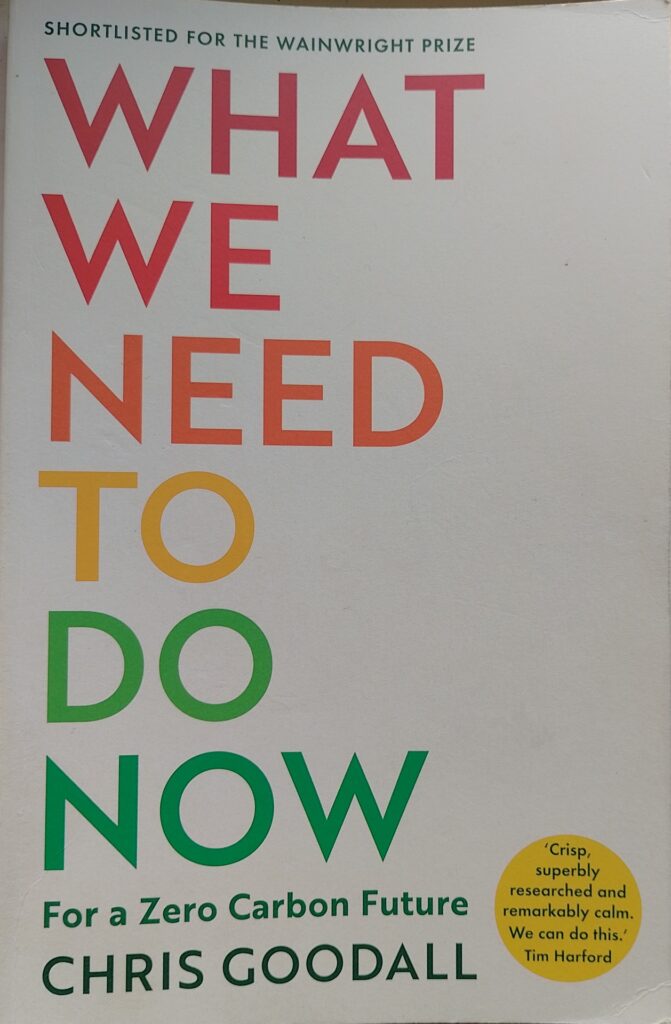First published 2020. Profile Books paperback, 2020, pp 215, c. 53,000 words.
In thirteen chapters, this book goes through each of the major sources of greenhouse gas emissions and explains what we (people, businesses and the government) need to do to reach net-zero by 2050. The book focuses on the UK, but the actions needed will be similar for all developed countries.
The UK is in the fortunate position of having a large, relatively shallow, continental shelf with substantial wind where large turbines can be relatively easily placed, and so Goodall focuses on the use of that resource to transform energy use towards electricity and hydrogen as an intermediate energy carriers.
The main sources of greenhouse gas emissions covered here are home heating, transport (land, sea and air), clothing, industrial production (notably metals and concrete) and food. Goodall recognises that it is very unlikely that emissions from these sources will be reduced close to zero by 2050 and therefore some forms of carbon sequestration will be required to achieve net-zero for the country as a whole. Later chapters focus on methods for reducing greenhouse gas emissions and increasing carbon sequestration, including taxation, reforestation, direct air capture of CO2, and geo-engineering. The final chapter lists a lot of things we individually can do to reduce our carbon footprint, making the point that it is not just governments that can and will have to take action to achieve net-zero.
Re-reading this after three years makes one realise what a mountain there is left to climb. Progress has been made on many fronts, but the road ahead is long and steep. Weak government is inclined to avoid the hard, unpopular choices: those that hit voters in their pockets. The good news is that the contribution of wind energy is increasing rapidly, and despite the recent set-backs of a failed auction, is likely to continue to do so. Connecting all that supply up to the grid and investing in energy storage or conversion to hydrogen are much more problematic. Many businesses are seeking solutions to their own emissions. Cars will almost all be electric by 2050, as will most other road vehicles, unless some other cost-effective ‘green’ fuel technology emerges. Further behind, but taking the problem seriously, are shipping and flying. With government pressure maintained, it is conceivable that these will be net-zero by 2050. More challenging, but not impossible, are steel and concrete production. Clothing and food are more difficult still because they are subject to individual choice and not so amenable to government dictate. It seems unlikely that nearly all hill farming of sheep will be replaced by forestry and the eating of beef replaced by other sources of protein, in large part because of the love of that tradition of landscape: very difficult, but not entirely impossible. Similarly with clothing: the industry may be conscious of its environmental damage, but consumers are unlikely to switch in significant numbers to buying more expensive but more durable clothing made from more sustainable materials.
Unlike many climate change activists, Goodall’s work is founded in economics rather than dreams. He suggests that coopting the strengths of the natural resource extraction companies would be more helpful than demonising them. As he says, there are many people employed in such firms who recognise the problem and would far rather be part of the solution. He is also, to a degree, a realist: recognising that net-zero will not be achieves unless active measures are taken to remove greenhouse gasses from the atmosphere. He outlines several possible approached to direct air capture of CO2 which are practical and would be economic with a not unrealistic tax on CO2 emissions. He is also not afraid of talking about geoengineering, unlike many. Having a practical geoengineering solution may reduce the pressure to drive to net-zero, but if getting there looks unachievable, then better to be developing those technologies now than leaving it until it gets too late.
On occasions Goodall muddies his practical analysis by suggesting political paths to take. Spreading benefits may be a worthy goal in itself but is not a direct driver of emissions reduction. Goodall might argue that only by spreading the benefits will broad political support be built for some of the drastic life-style changes necessary. He may be right, but that is another debate. Taxation and redistribution might be a more achievable method. Not every community has the spare skills and capacity of somewhere like Oxford.
Goodall writes well, in a largely jargon-free way. This makes for a very accessible and easily understood plan. One feels that there has been a lot of research and analysis behind the arguments he makes, but these do not get in the way of a clear message: it’s going to be tough, very tough. A note at the start of the book says that sources of information for the book are available on Goodall’s Carbon Commentary website. If they are, they are well hidden, which is a pity because it would have been good to check up on progress from some of the sources.
One solution to human-induced climate change and general environmental damage not mentioned would be for all humans to stop having children. That is the greenest lifestyle choice of all and more effective than taking the odd train rather than aeroplane flight.
This book makes for depressing reading, but not entirely so. There is an immense and steep mountain to climb, but as mapped out here, a path to the summit can be discerned.
Disclosure: I worked for a consultancy firm that Chris Goodall ran back in 1987-88. Happy days.
Wikipedia biography of Goodall: https://en.wikipedia.org/wiki/Chris_Goodall
Others’ reviews of the book: https://www.goodreads.com/book/show/50345546-what-we-need-to-do-now?ref=nav_sb_ss_3_16
© William John Graham, December 2023

